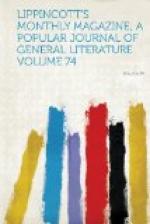As a corollary to this assiduous culture, French art collectively was at the exposition “first, and the rest nowhere.” The old works sent by Italy stood by themselves; and in mosaic, Salviati’s glass, and statuary led by Vela’s Last Moments of Napoleon, the modern studios of that country ranked in the front. Prussia had some heliographic maps, then a new thing, and chromos, also in the bud; Austria and England, fine architectural drawings; and Eastlake, Stanfield, Landseer, Frith and Faed crossed pencils with the French. But nothing modern of the kind could stand by the porcelain of Sevres, the glass of St. Louis and Baccarat, the bronzes of other French producers, the vast collection of drawings of ancient and mediaeval monuments and architecture in France, her book-binding and illustration by Bida and Dore, her jewelry and her art-manufactures as a whole. In carriages she had obviously studied the turnouts of American workshops to advantage.
In agricultural machinery all civilized exhibitors had gone to school to our artisans.
One of our specialties, a postal-car, appeared under the Prussian flag. So did things more legitimately the property of the nascent empire. The Krupp gun cast its substance, as well as its shadow, before. A locomotive destined for India made Bull rub his eyes. Chemicals in every grade of purity spoke the potency of the German alembic.
The probability that the production of beetroot-sugar would before many years attain a position among the industries of this country gave interest in the eyes of American visitors to the display of European machinery employed so successfully in that business. Labor-saving machinery we have not generally been in the habit of borrowing. Neither, on the other hand, has Europe been accustomed to draw from us crude material for the finest manufactures; and the balance was set even by the admirable quality of the glass made from American sand and the porcelain moulded in American kaolin. The latter substance, a silicate of alumina, is not found in England, and at but few points on the Continent. We have it in abundance and of the finest quality.
[Illustration: GRAND VESTIBULE OF THE PARIS EXPOSITION BUILDING, 1867.]
The extraordinary steps made within five years in the arts of destruction were illustrated by the twelve-inch Armstrong rifles of England and the Essen gun, throwing a 1212-pound shot. In 1862 the heaviest projectile shown did not exceed one hundred pounds. For field-service the limit of practice in weight seems long ago to have been reached: for forts and ships it cannot be far off. Armor and projectiles must soon bring each other to a standstill; as when, in the Italian wars of the fifteenth century, offence and defence reached the reductio ad absurdum of the incapacity of men-at-arms to inflict serious injury upon each other, or even to pick themselves up when the weight of their armor, with some aid from




